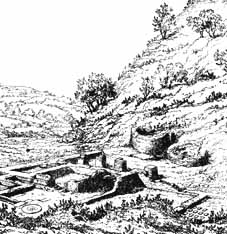 |
||||||||
| Early copy of a painting by Michael Rooker. Newport Museum and Art Gallery hold the copyright on the original. | ||||||||
|
Caerleon Castle, painted by Michael Rooker in 1787. The original watercolour is in Newport Museum & Art Gallery. It was purchased from Kyrle Fletcher's Antique shop in High Street Newport in 1930. Luckily this copy was made before then, so we believe we are able to display it without contravening copyright laws - if we are wrong please let us know and we will remove this page immediately. Michael Rooker (1746 - 1801) was an accomplished artist. His topographical drawings and paintings were very detailed, it has been said he "drew buildings as if he loved every brick and stone." He was a professional pupil of Paul Sandby who gave him the nickname Michael "Angelo" Rooker. As well as being a painter he was a proficient engraver and produced prints from his own topographical drawings. He also was employed as a scene painter for the theatre. Many of his works were produced when he went on walking tours - it seems likely that the view above was one such piece. It is a mark of how highly he was thought of, that, on his death, JMW Turner purchased more than a dozen of his works. Underneath the rather blurred image of this painting in Primrose Hockey's book (see above) was the caption "Building the tram road." This can not be the case if the picture was painted in 1787 as the tramroad was constructed in 1794. (See our section on the Caerleon Tramroad.) It is more likely that the stone from the castle ruins was being wheeled away to build or repair houses in the village. |
||||||||
| Right, the direction of view is indicated with a red arrow. The plan is taken from the 1849 publication "Remains of Roman Villa &c &c In The Castle Grounds Caerleon," by John Edward Lee. Thanks to the handiwork of the above men and their wheelbarrows, only the foundations of the circular structures remained. Clearly we are looking SSE. Therefore, before us, must be the end house facing the Mynde on Castle Street. Notice the raised area to the right of the painting. This corresponds with the roman remains, visible in the centre of the picture below, uncovered by John Jenkins and recorded by John Lee. |  |
|||||||
 |
||||||||
| Left, section of a print from the
same publication. Note the remains of the two towers at the foot of the
Mound and the particularly high roman remains in the centre of the view.
To find out more about the excavations carried out by Lee in the 19th
Century visit our section on the Mynde. |
||||||||
